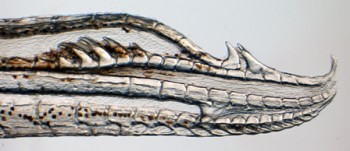New mosquitofish ‘hooks up’ with females
A new species of Gambusia has several interesting – “and perhaps cringe-inducing” – characteristics, including a series of four hooks on the male genitalia, said North Carolina State University this week.
Females of the new species – the llanos mosquitofish, or Gambusia quadruncus – also have distinguishing characteristics, including a colorful anal spot, although the specific name is derived from the latin quad (meaning four) and uncus (hook) in reference to the gonopodium of the male. It lives in a diversity hotspot and seemingly branched off from its closest relative more than one million years ago.
Dr. Brian Langerhans, assistant professor of biology at NC State and the lead author of the description paper, says that these interesting characteristics may play important roles in mating control and success.
While more research is needed, Langerhans says that four-hooked genitalia on males can serve a purpose when females attempt to block or restrict mating attempts.
“Typically, reproduction is more costly in females, so females favor ways of reducing mating with ‘lower quality’ males,” Langerhans says, “but reproduction is cheap in males and so selection favors ways of mating with as many females as possible. In Gambusia, some females, includingG. quadruncus, have evolved modifications that appear to function as a blocking device – essentially a big ball of tissue blocking most of the genital pore – restricting entry of the male’s gonopodial tip. Thus, the female would have to behaviorally allow the male to mate or the male would have to evolve a counter response to avoid this problem.”
The four-hooked genitalia could be that counter-response, Langerhans says.
“Having four hooks on the gonopodium may provide a means of overcoming female resistance, latching on to the gonopore and transferring sperm in a manner that facilitates effective sperm transfer. Or it may serve to stimulate the female in a manner that causes responses in the female that facilitate effective sperm transfer,” Langerhans says.
Somewhat similarly, the colorful anal spot on females appears to serve as a signal that only certain males are desired for mating.
“The differing, species-specific female anal spots appear to influence male mating behavior by signaling the location of the gonopore to the male, sometimes indicating the reproductive status of the female, and distinguishing fish of their own species from fish of other species to reduce costly cross-breeding, which can result in fish with reduced fitness,” Langerhans says. “So it may be that G. quadruncus evolved different anal spots to help reduce interspecies matings and possible formation of hybrids.”
For further information please refer to the paper: Langerhans, R. B., M. E. Gifford, O. Domínguez-Domínguez, D. García-Bedoya, and T. J. DeWitt. 2012. Gambusia quadruncus (Cyprinodontiformes: Poeciliidae): A new species of mosquitofish from east-central Mexico. Journal of Fish Biology 81(5): 1514-1539.
This blog post was prepared from a press release supplied by North Carolina State University.
Category: Blogs, Discoveries | Tags: Gambusia, gonopodium, mosquitofish, penis, quadruncus | Comment »




Product reviewers wanted
Are you still looking for product reviewers?
19th Dec 2024
Product reviewers wanted
Hey! Interesting article!
17th Dec 2024
Site improvements
Got it! Thanks for the update. It's good to know that Seriously Fish is working on improving the site's performance and addressing the email and forum...
21st Nov 2024
Responsive design
Nice
13th Nov 2024
Responsive design
it is a complete malfunctioning horror on iphone and ipad.
10th Nov 2024